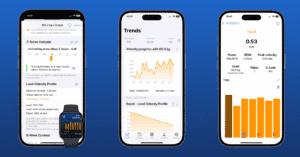In the ever-evolving world of fitness and performance, integrating data seamlessly across platforms is essential for athletes focused on maximizing their velocity based training (VBT). Spleeft, an app designed for real-time measurement of barbell velocity and jump height, now allows athletes to sync with popular training platforms like TrainingPeaks, Strava, TrainAsONE, and Intervals.icu through Apple Health and the HealthFit app. This article will walk you through why syncing Spleeft with each platform is beneficial and provide detailed, step-by-step instructions on how to sync with each, giving you complete control over your VBT journey.
DOWNLOAD SPLEEFT APP NOW FOR iOS, ANDROID AND APPLE WATCH!
Sync Spleeft with TrainingPeaks, Strava, TrainAsONE & Intervals.icu
TrainingPeaks for Velocity-Based Training

Why Sync Spleeft with TrainingPeaks?
TrainingPeaks is renowned for its in-depth analytics and ability to optimize training through data. By syncing Spleeft with TrainingPeaks, athletes focused on strength and power gains can access load-velocity and power-load data from their Spleeft sessions alongside their endurance metrics. This comprehensive data view helps athletes track long-term progress in key VBT metrics and adjust training intensity based on velocity data trends.
When you connect Spleeft with TrainingPeaks, you enable a deeper understanding of how load and velocity work together to build power. Imagine you’re prepping for a competition; TrainingPeaks can analyze your Spleeft data to help fine-tune training loads, align intensity with goals, and avoid overtraining by adjusting for central nervous system (CNS) fatigue based on recent velocity loss trends. TrainingPeaks for velocity based training brings unparalleled insight into performance, ensuring each session aligns with your overall goals.
Step-by-Step Guide to Sync Spleeft with TrainingPeaks
- Open Spleeft and Enable Apple Health Sync: Go to Spleeft’s settings and activate Apple Health Sync. This step allows Spleeft to share your velocity-based training data with Apple Health. Maybe this step is already done, as Spleeft asks you to do it in the first open.
- Download HealthFit: Head to the App Store and download HealthFit, the app that enables syncing from Apple Health to TrainingPeaks.
- Set Up HealthFit: Open HealthFit and connect it to your Apple Health account. From there, select TrainingPeaks as a sync option.
- Customize Data Sync: In HealthFit, choose which Spleeft data to sync. VBT tracking metrics like barbell velocity, jump height, and load-velocity profiles are not synced yet.
- Enable Auto-Sync: Turn on auto-sync in HealthFit to ensure that each new Spleeft session is automatically sent to TrainingPeaks. You can also export each workout manually.
Enable automatic sync to TrainingPeaks or your favourite platform in your HealthFit profile. Spleeft workouts are saved as Strength Training.
With this setup, every Spleeft session is integrated into TrainingPeaks, enabling a streamlined approach to your velocity-based training journey.
Strava for Velocity-Based Training

Why Sync Spleeft with Strava?
Strava’s global community and GPS tracking capabilities make it a favorite among athletes for sharing performance stats and connecting with fellow fitness enthusiasts. Integrating Spleeft with Strava for velocity-based training allows strength-focused athletes to incorporate barbell velocity and jump metrics into their profiles, combining these unique metrics with endurance activities like running or cycling.
Syncing Spleeft with Strava means that athletes who split their time between strength and endurance have a centralized platform to track all aspects of their training. For example, you might complete a strength session focused on velocity-based training in the morning and log a long run in the afternoon. With Spleeft and Strava working together, you can view the effect of endurance workouts on VBT metrics like jump height or barbell velocity, allowing you to adjust your intensity to avoid overtraining and optimize recovery.
Step-by-Step Guide to Sync Spleeft with Strava
- Activate Apple Health Sync in Spleeft: Open Spleeft and enable syncing with Apple Health. This will allow your velocity-based training data to be shared with the Apple Health app.
- Install HealthFit: Download the HealthFit app from the App Store, which facilitates data transfers from Apple Health to other platforms, including Strava.
- Link HealthFit to Apple Health and Strava: Open HealthFit, grant permission to access Apple Health, and select Strava as one of the platforms for data syncing.
- Choose Data Points: Within HealthFit, select which data points to share. VBT data like barbell velocity, jump height, and power output are not synced yet.
- Enable Continuous Sync: Set HealthFit to auto-sync, ensuring that every Spleeft session automatically uploads to Strava.
With your data synced, Strava provides a space to track both strength metrics and endurance achievements in one platform, making it easier to balance and optimize across different training styles.
TrainAsONE for Velocity-Based Training

Why Sync Spleeft with TrainAsONE?
TrainAsONE is an AI-powered training platform that adapts workout plans based on real-time data, making it an ideal choice for athletes looking to integrate strength metrics from velocity-based training into an adaptive schedule. By syncing Spleeft with TrainAsONE, athletes can benefit from custom programs that adjust based on their barbell velocity and power metrics, tailoring each day’s training load and intensity to suit current recovery levels and performance goals.
For example, if Spleeft records a decrease in barbell velocity indicating potential fatigue, TrainAsONE can reduce the intensity of the following day’s workout to avoid overtraining. This adaptive approach is beneficial for athletes juggling various training demands, as it ensures each workout maximizes gains without risking burnout. TrainAsONE for velocity-based training provides a highly personalized experience that continuously adapts based on daily performance metrics.
Step-by-Step Guide to Sync Spleeft with TrainAsONE
- Enable Apple Health Sync in Spleeft: In Spleeft’s settings, activate Apple Health Sync to share your velocity-based training data.
- Download HealthFit from the App Store: HealthFit enables seamless data transfer from Apple Health to TrainAsONE.
- Connect HealthFit to TrainAsONE: Open HealthFit, connect to Apple Health, and select TrainAsONE as a destination for your data.
- Turn On Auto-Sync: Enable continuous syncing in HealthFit so that every Spleeft session updates TrainAsONE automatically.
By syncing Spleeft data to TrainAsONE, you unlock a training plan that adapts to your current strength metrics, making it easier to maintain progress and achieve long-term goals while avoiding overtraining.
Intervals.icu for Velocity-Based Training

Why Sync Spleeft with Intervals.icu?
Intervals.icu is a powerful platform for athletes who want to dive deeply into data analytics and monitor performance trends. Known for its advanced customization, Intervals.icu is ideal for tracking VBT metrics over time, making it a great fit for athletes who use Spleeft to measure barbell velocity and jump height. By connecting Spleeft to Intervals.icu, athletes can visualize their load-velocity profiles, track power output, and assess how their strength training evolves over weeks and months.
For instance, a CrossFit athlete might use Spleeft to track barbell velocity during Olympic lifts and sync this data with Intervals.icu to identify fatigue trends. Intervals.icu’s customizable charts can reveal decreases in velocity across sets, signaling that a lighter load might be needed in future sessions to maintain performance. This kind of data analysis is invaluable for athletes managing complex training schedules, as it allows for precise adjustments based on detailed performance insights.
Step-by-Step Guide to Sync Spleeft with Intervals.icu
- Activate Apple Health Sync in Spleeft: Start by enabling Apple Health Sync in Spleeft’s settings. This makes your velocity-based training data available in Apple Health.
- Download and Open HealthFit: Get HealthFit from the App Store, which facilitates syncing Apple Health data with Intervals.icu.
- Link HealthFit to Intervals.icu: Open HealthFit, allow it to access Apple Health, and add Intervals.icu as a sync destination.
- Enable Automatic Updates: Turn on auto-sync in HealthFit to ensure that every session in Spleeft is instantly reflected in Intervals.icu.
How to Make the Most of Velocity Based Training Data across Platforms
Syncing Spleeft with TrainingPeaks, Strava, TrainAsONE, and Intervals.icu allows athletes to leverage the power of VBT data within a wider training ecosystem. Here are some strategies to maximize the value of these integrations:
Leverage Velocity Data for Autoregulation
Using velocity metrics for autoregulation allows athletes to adjust intensity in real-time based on performance. Platforms like TrainingPeaks and TrainAsONE make it easy to monitor and adjust training loads based on Spleeft’s velocity data, ensuring that each session aligns with the athlete’s current physical state.
Track CNS Fatigue through Velocity Loss
Velocity loss across sets is a powerful indicator of fatigue. By syncing this data with Intervals.icu and TrainingPeaks, athletes can gain insight into their readiness to train and schedule optimal recovery periods, minimizing injury risk and enhancing performance.
Use Load-Velocity Profiles for Optimized Power
Spleeft’s load-velocity profiles are ideal for strength athletes looking to optimize power output. TrainingPeaks and Intervals.icu both support detailed tracking and analysis, helping athletes target specific loads for peak power, which is essential during competition phases or high-intensity training blocks.
Final Thoughts
Syncing Spleeft with TrainingPeaks, Strava, TrainAsONE, and Intervals.icu opens up a world of possibilities for athletes focused on velocity-based training. Each platform offers unique tools that help athletes tailor their training based on VBT metrics, whether you’re looking for adaptive AI-driven programs with TrainAsONE, community tracking with Strava, detailed performance analysis with Intervals.icu, or comprehensive training insights with TrainingPeaks.
By following the step-by-step guides above, you can seamlessly integrate Spleeft’s data across these platforms, creating a training ecosystem that maximizes the benefits of VBT. Each integration enriches your performance tracking, helping you reach your goals more effectively and making the most of every workout.






2 Comments
Buenas tardes, quiero pasar mis datos de spleeft de entrenamiento de fuerza basado en velocidad a mi cuenta de Training Peaks , esos datos para poder ser pasados tienen que ser grabados con Apple Watch o siendo esos datos grabados con el móvil también me los
Vincula a Training Peaks
¡Hola Manuel! Gracias por dejarnos tu pregunta en comentarios, para poder pasar los datos de Spleeft de Entrenamiento de fuerza basado en la velocidad a Training Peaks siempre debe ser con el Apple Watch a través de Apple Health. Ya que es como se mide frecuencia cardiaca, tiempo, etc. Porque con el iPhone esos datos no son medidos.
Un saludo.